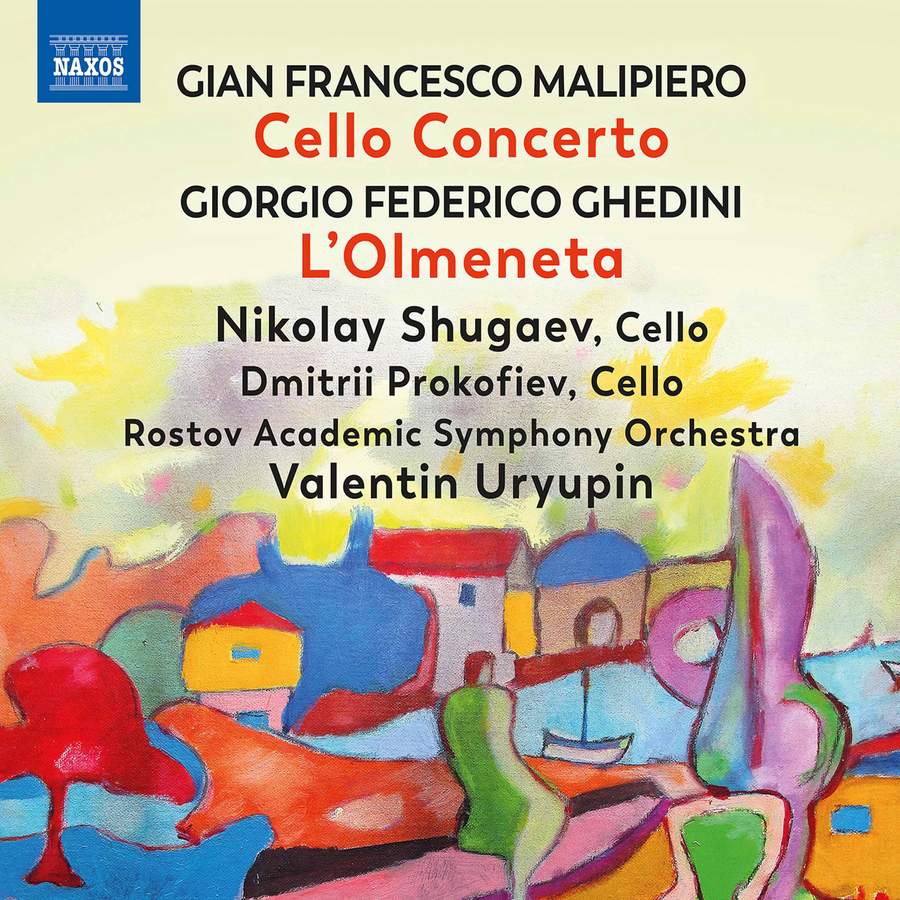GHEDINI L'Olmeneta MALIPIERO Cello Concerto
View record and artist detailsRecord and Artist Details
Genre:
Orchestral
Label: Naxos
Magazine Review Date: 07/2022
Media Format: CD or Download
Media Runtime: 55
Mastering:
DDD
Catalogue Number: 8 574393

Tracks:
| Composition | Artist Credit |
|---|---|
| Concerto for Cello and Orchestra |
Gian Francesco Malipiero, Composer
Nikolay Shugaev, Cello Rostov State Philharmonic Academic Symphony Orchestra Valentin Uryupin, Conductor |
| L’Olmeneta (The Elm Grove) |
Giorgio Federico Ghedini, Composer
Dmitrii Prokofiev, Cello Nikolay Shugaev, Cello Rostov State Philharmonic Academic Symphony Orchestra Valentin Uryupin, Conductor |
| Notturno e tarantella |
Alfredo Casella, Composer
Nikolay Shugaev, Cello Rostov State Philharmonic Academic Symphony Orchestra Valentin Uryupin, Conductor |
Author: Andrew Farach-Colton
There are passages in Gian Francesco Malipiero’s 1937 Cello Concerto that sound as if they might have come from a composer of the English pastoral school – particularly in the modal harmonies and winding melodies of the opening Allegro moderato and the central Lento. The finale comes as a surprise after such overwhelmingly lyrical writing, beginning rather like a car motor that won’t quite turn over (and aided by percussive jolts from the snare and bass drums). This leads to an extensive cadenza whose insistent chords have something of the earthiness of Kodály’s Solo Sonata, Op 8, and the movement is more than half over when the engine finally starts purring (around 3'17").
Malipiero’s work is attractive enough, although it lacks the imaginative, memorable character of cello concertos by, say, Finzi or Moeran. Giorgio Federico Ghedini’s double concerto L’olmeneta (‘The Elm Grove’) from 1951, on the other hand, deserves wider attention. The composer described its mood in autumnal images – an old farmhouse set among elm trees deeply rooted in ‘soil on whose surface the golden colours of innumerable autumns have built up and darkened’. One hears the entangled roots at the start in a passage that evokes the sonorous elemental Prelude to Wagner’s Das Rheingold. There’s a pastoral tone in L’olmeneta as there was in the Malipiero but it’s one that’s distinctly less sweet, with soft yet insistent harmonic friction that is perhaps meant to make audible the soil darkened by decay.
L’olmeneta is cast in four movements that last a good half-hour in total, although only the very brief second-movement hunting scene moves quickly. This is followed by an expansive and delicately scored Molto adagio full of long shadows and lyrical ache (I hear echoes of Shostakovich and Britten in it). The finale has some marvellous moments, too – listen, say, at 1'41", where the cellos move in tandem over shifting chords in a manner that’s not so far in spirit from late Sibelius. Ghedini’s voice is his own, mind you, and in its language and colouring L’olmeneta casts a subtle yet powerful spell.
Alfredo Casella’s Nocturne and Tarantella (1934) serves here as a sweetly scented encore. Nikolay Shugaev is an eloquent soloist in all three works, he and Dmitrii Prokofiev are well matched in the Ghedini, and the Rostov Academic Symphony Orchestra provide sensitive support throughout under the direction of Valentin Uryupin. Strongly recommended, then, for Ghedini’s concerto; its unique atmosphere continues to haunt me.
Discover the world's largest classical music catalogue with Presto Music.

Gramophone Digital Club
- Digital Edition
- Digital Archive
- Reviews Database
- Full website access
From £8.75 / month
Subscribe
Gramophone Full Club
- Print Edition
- Digital Edition
- Digital Archive
- Reviews Database
- Full website access
From £11.00 / month
Subscribe
If you are a library, university or other organisation that would be interested in an institutional subscription to Gramophone please click here for further information.




